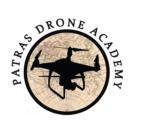Special Category
Welcome to Patra Drone Academy, the leading training institute for the Special Drone Class in Greece. We are dedicated to providing high quality and comprehensive training for professional Drone pilots
Our training program covers the training requirements in the two standard Scenarios STS-01 (PDRA–S01) and STS-02 (PDRA–S02) providing our students with the necessary knowledge and skills for the safe and effective operation of drones.
The theoretical part of the programme includes a wide range of topics covering the requirements and specifications of each specific category. Our students will gain knowledge about the legislation and regulations governing Drone in Greece and the European Union as well as aviation knowledge about flight safety, risk identification and more.
In the practical part of the program, our students will gain practical skills and experience in operating drones, identifying and using various sensors and equipment, as well as performing category-specific functions STS-01 (PDRA–S01) and STS-02 (PDRA–S02). Students will be trained in a real & safe environment and gain the confidence to respond to real-life situations and challenges.
At Patra Drone Academy, we have qualified staff and modern equipment to ensure a comprehensive training experience. The training takes place in a student-friendly atmosphere, with professional instructors who have extensive knowledge and experience in the field of Drone.
Upon completion of the training program, students receive the recognized certificate for the special category STS-01 or STS-02, which confirms their knowledge and skills in the field of Drone. This certificate opens up new opportunities for professional development and activity in the Drone industry, allowing its holders to work in specialised operations and flight programmes.
Throughout your STS-01 or STS-02 Special Category training, we will be by your side to help you succeed in the demanding Special Category and fulfil your professional ambitions.
Special Category
Drone operations in the Special Category under the new rules of the EASA usually involve circumstances that do not meet the requirements of the Open category. This may be the case, for example, if it is necessary to higher altitude or if the drone needs to fly beyond the operator’s field of vision (BVLOS).
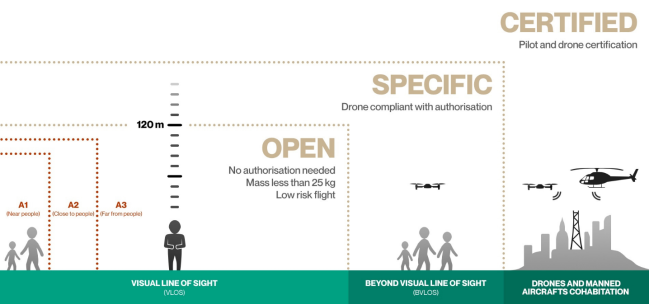
Drone Operators are likely to operate mainly in the Open Category according to EASA regulations. The legislator has created the Open Category for operators who do not require a prior licence from the competent authority of the respective EU Member State.
Once operations become more complex and even one requirement of the Open category cannot be met, the entire mission is immediately moved to the Special category.
The Special category concerns medium risk operations. Approval is required before operation.
To enable such drone operations to be carried out with as little bureaucracy as possible in the future, a number of formal procedures are set out to speed up the approval process.
Is that why there are standardised scenarios (STS)?
As the name suggests, so-called standardised scenarios describe the procedures and instructions for missions that are performed more frequently and have a similar risk profile.
Therefore, STS significantly minimise the approval procedures for Special Category operations because important key points such as risk have already been clarified in advance in accordance with EASA legislation.
Educational programme ” Standard Scenario STS”
The training programme for the special categories STS-01 and STS-02 for drones includes theoretical and practical training covering various areas relevant to the safe and professional operation of drones
The training programme includes:
- Theoretical training in the compulsory syllabus for the Standard Scripts.
- Theoretical exams (Proctored Online Exam or face-to-face) in the Standardized Scenarios. Theoretical training and examinations in the compulsory A1-A3 syllabus (for those who do not hold an A1-A3 Open Category certificate).

Duration & procedure of the theoretical courses.
The theoretical courses are conducted online through the school’s platform in asynchronous education ,in each module you will find audiovisual material , textbook in digital format & multiple choice questionnaires for unlimited use. You watch freely, without daytime commitments & the theoretical courses. The duration depends on the speed with which each person can assimilate the information and proceed with the training.
Free online training provides the flexibility to adjust the pace of learning according to your own needs and commitments. You can proceed at your own pace and repeat the lessons whenever you feel it is necessary. A2 Open Category Certificate holders will have a reduced syllabus.
What the theoretical courses include.
The STS theory course consists of the following eight (8) modules, which you must have attended and completed before taking the theory exam:
- Legislation on aviation
- Human performance constraints
- Operational procedures
- Methods of technical and operational mitigation of risks on the ground
- General knowledge of SSEA
- Meteorology
- The flight performance of the SMEE
- Methods of technical and operational mitigation of airborne hazards
Holders of an A2 Open Category certificate are exempt from part of the theory and the course includes only modules 1 to 5.
The theory examinations and how they are conducted.
The theoretical exams cover a wide range of topics related to safety, legislation, technique and procedures related to Drone flight operations
The STS-01 & STS-02 theoretical exams are written, multiple-choice and are conducted online using the PROCTORED ONLINE EXAM method or in person at our training center. The tests are based on a familiar multiple-choice questionnaire:
1) 40 questions if you do not hold an A2 Open Category certificate
2) 30 questions if you hold an A2 Open Category certificate
The time to complete the Theoretical Examination for the special categories STS-01 and STS-02, is 45 minutes, usually students complete the examination in 15 minutes on average and to be considered successful one must have 75% or more correct answers.
The first standard scenario published by EASA is called STS-01 and is defined forUAS V-LOS operations in a controlled terrain area in a populated environment.
UAS not assigned to category C1 (e.g. heavier than 900 g) and not assigned to category C2 (e.g. heavier than 4 kg) are only allowed to operate in OPEN A3 category. This means, for example, that businesses in residential or industrial areas generally no longer apply, as subclass A3 requires a minimum distance of 150 m from these areas.
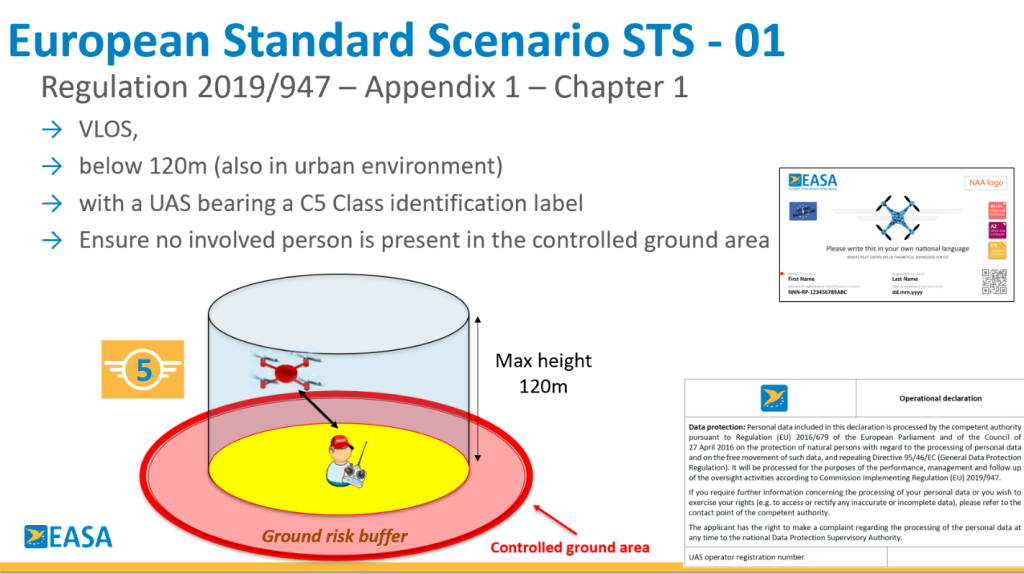
Drones that are certified according to class C5 offer the solution. As part of the use of a standard scenario, they allow the use of larger and heavier drones even in populated areas.
Examples of use cases would be:
- Mapping of settlements
- Photogrammetry
- Precision agriculture
- Aerial spraying
- Surveillance & Inspection
- Cargo transportation
- Thermographic analysis of photovoltaic systems in residential and commercial areas
- Filming cities with big (and heavy) drones
Conditions of the standard scenario STS-01
Similar to the A1, A2 and A3 subcategories in the OPEN category, STS-01 imposes strict requirements within which flights in the Special Category must be performed in order to be covered by the standard scenario.
The following requirements must be strictly observed:
- The flight must be conducted under V-LOS conditions at all times.
- The maximum flight altitude can be 120 m (AGL). Exceptions are artificial obstacles (e.g. wind turbines) where UAS can fly up to 15 m above the highest point of the obstacle if the lateral distance between the UAS and the obstacle is less than 50 m and if the height of the obstacle is greater than 105 m. A prerequisite for this is that the owner of the structure has agreed to this overflight.
- The flight must take place in a controlled area of the ground. This area must be secured/excluded by the Operator. The size of the Ground Risk Buffer depends on the maximum flight altitude and the MTOM of the UAS used.
- The maximum speed of the UAS shall not exceed 5 m/s.
- Must use a drone certified according to Class C5 .
- The operator must have completed the appropriate certificate Standard Scenario STS and have completed the relevant practical training.
- There must be adequate insurance coverage.
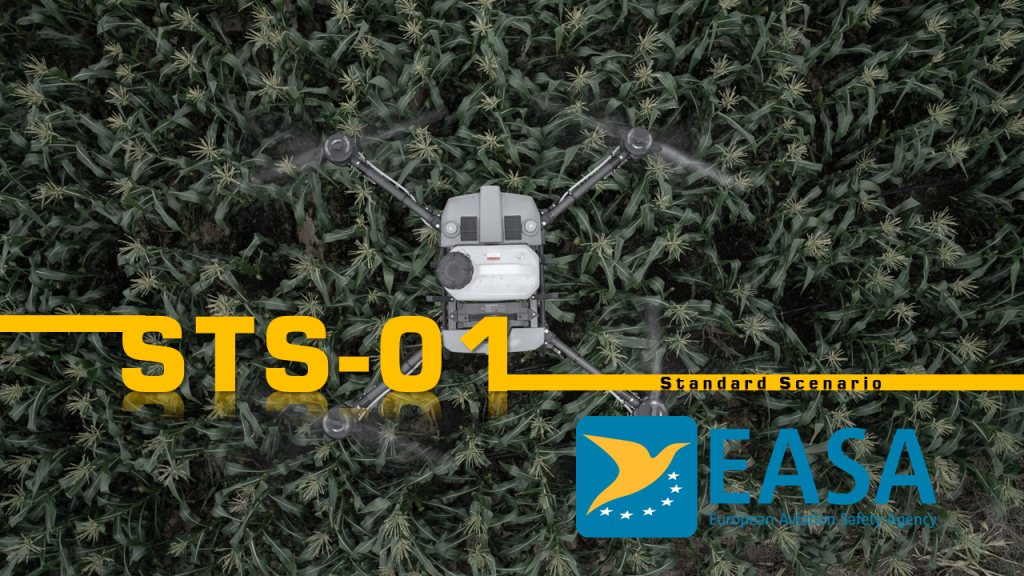
The theoretical training for the special category STS-01
It includes gaining knowledge and understanding of the regulations, legislation and requirements applicable to the Special Category of Drone. Pilots wishing to obtain STS-01 certification must become familiar with the following topics:
-
- Legislation and regulatory framework: You should be aware of the regulations and laws governing the operation of drones, as well as the restrictions and requirements that apply to STS-01 class specific operations.
- Flight safety: you need to understand the risks associated with flying a Drone and the methods required to avoid accidents. This includes identifying environmental hazards, reacting to unforeseen situations and safe flight.
- Aeronautical knowledge: You should understand basic aeronautical principles and concepts such as aerodynamics, air traffic control, air charts and meteorological conditions that affect the flight of drones.
- Human factor: Human performance is affected by many factors, such as fatigue, stress, concentration and the right reaction to critical situations.
- Drone systems: you should familiarise yourself with the technology and systems that make up drones, including sensors, imaging equipment, the flight system and the controller.
The theoretical training for the special class STS-01 is designed to provide you with the necessary knowledge and understanding to safely and successfully perform the special operations of the Drone. ( link ELECTRONIC REGISTRATION )
STS-01 Flight Training
The flight training for the Special Category STS-01 includes practical training on the field. During flight training, pilots acquire the necessary skills and knowledge to control the Drone safely and efficiently. Flight training includes some of the following subjects:
- Familiarity with the Drone:
- Familiarization with the anatomy and structure of the Drone.
- Learning the operation and controls of the Drone.
- Training in assembly, pre-flight inspection of the Drone and its maintenance.
- Flight exercises:
- Perform basic movements and manoeuvring of the Drone.
- Take-off and landing exercises.
- Performing flights in various directions and altitudes.
- Flying at various speeds and inclinations.
- Performing control and dexterity exercises.
- Exercises to adapt to changing weather conditions.
- Security and risk management:
- Learning the necessary preventive measures for flight safety.
- Understanding the restrictions and regulations regarding Drone flight.
- Identify and address in-flight risks and problems.
- Training to avoid collisions with other aircraft or objects.
It should be noted that flight training takes place primarily in a controlled environment, pilots are required to follow all safety instructions and comply with the requirements of the aviation authority during flight training. e-Registration link )
The second standard scenario published by EASA is called standard scenario
STS
-02
and is defined for the operation of B-VLOS drones with an airspace observer in a controlled ground area over sparsely populated areas.

The UAS mode beyond the pilot’s field of view automatically exits the Open category. With the STS-02, EASA offers a standard scenario that allows B-VLOS flights with drones. Drones certified according to the C6 class are offered as a solution. As part of the STS use, they allow the use of drones beyond the pilot’s field of view, with the use of an Airspace Observer ( )if required, in sparsely populated areas.
Examples of use cases would be:
- Long range photogrammetry work,
- Aerial spraying
- Inspections
- Inspections
- Cinematography,
- Cargo transport
- Vegetation analysis of large cultivated areas
Conditions of the STS-02 standard scenario
Similar to subcategories A1, A2 and A3 in the OPEN category, STS-02 imposes strict requirements within which operations in the Special Category must take place in order to be covered by the standard scenario.
The following general requirements must be complied with:
- The maximum flight altitude can be 120 m (AGL). Exceptions are artificial obstacles (e.g. wind turbines) where UAS can fly up to 15 m above the highest point of the obstacle if the lateral distance between the UAS and the obstacle is less than 50 m and if the height of the obstacle is greater than 105 m. A prerequisite for this is that the owner of the structure has agreed to this overflight.
- The flight must take place in a controlled area of the ground. This area must be secured/excluded by the Operator. The size of the Ground Risk Buffer depends on the characteristics of the UAS.
- Must be used drone certified according to Class C6 .
- The drone must have Remote ID enabled.
- The drone must have a geofencing system that prevents it from leaving the designated flight area.
- the operator must have completed the appropriate STS certificate and have completed the relevant practical training.
- There must be adequate insurance coverage.
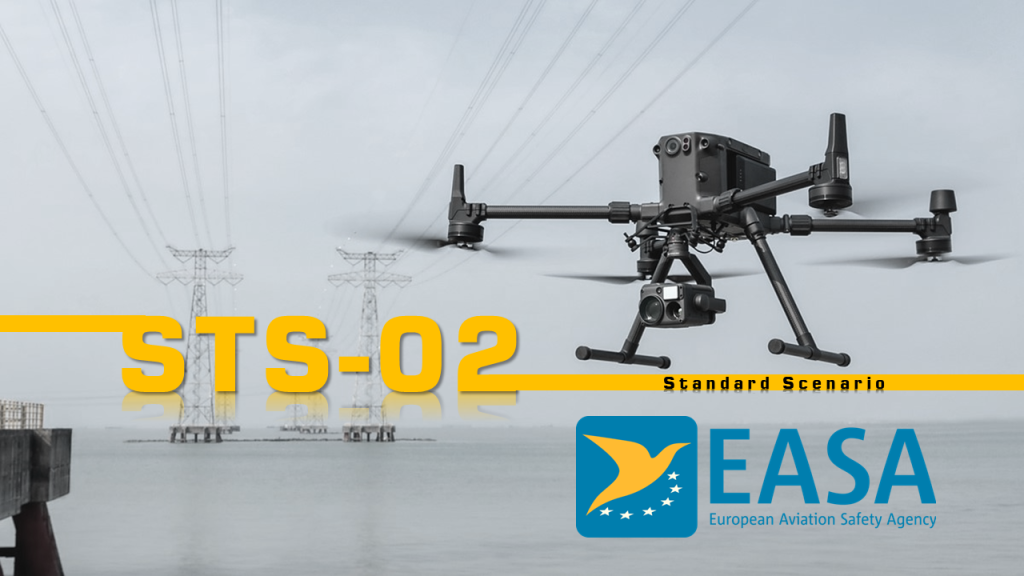
The theoretical training for the special category STS-02
- The special category STS-02 refers to operations Flying Beyond Visual Line of Sight (BVLOS) With the special category STS-02, pilots can fly beyond visual line of sight, i.e. away from the area where they can see them directly. This requires the use of advanced collision detection and avoidance systems.
- Flights with special requirements from the pilot: STS-02 pilots can perform flights that require special knowledge, skills and experience. These may include irreparable damage, extremely high risks or environmental impacts. (
e-Registration link
)
STS-02 Flight Training
The flight training for the special category STS-02 includes advanced skills and knowledge for the safe and professional flight of drones. During the STS-02 flight training, pilots are specialised in advanced techniques and procedures to perform flights with higher complexity and special operations. Below are some of the topics included in the flight training for the STS-02 category:
- Advanced flight techniques:
- Longer range flights beyond visual contact (BVLOS)
- Performing complex manoeuvres.
- Dealing with emergencies:
- Training for in-flight crisis and emergency management.
- Dealing with adverse events and problems that may occur during the flight.
The above is a general overview of the topics that can be covered in flight training for the STS-02 special category (
e-Registration link
)
What is the difference between STS, PDRA and SORA?
Depending on the type, the area of operation and the drone we use, the appropriate approval is required according to EU Legislation 2019/947
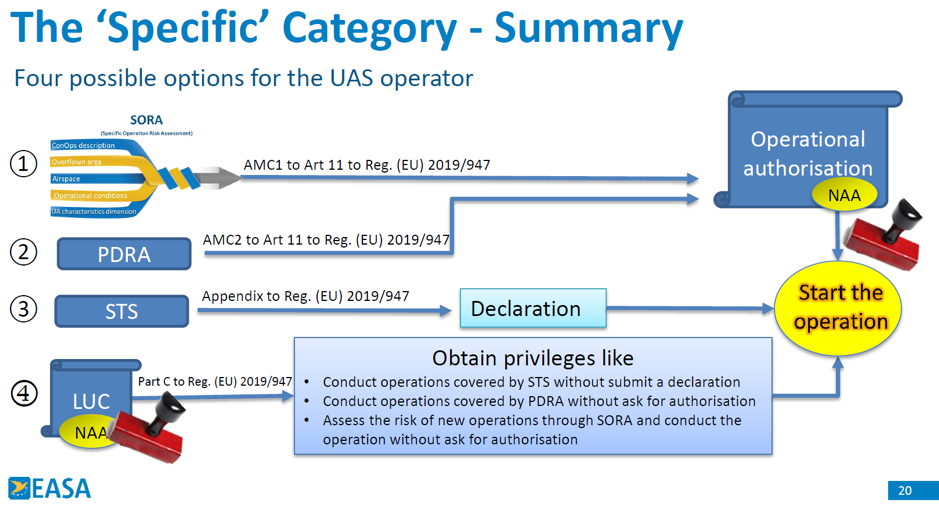
STS – Standardised Scenarios
Allows drone operations under precisely defined conditions, which due to their requirements must take place outside the Open category.
STS is only available for certified C5 and C6 class drones . For this purpose, activity under STS is possible through simplified notification to the competent authority using a standardised form. A licence for the activity will no longer be required for businesses covered by STS scenarios. Of course, this assumes that the flight plan is covered by a published STS scenario.
The STS have already been legislated across the EU by EASA and will apply from 1 January 2024 is:
- Standard Scenario STS 01: VLOS
- Standard Scenario STS 02: B-VLOS
PDRA – Pre-Determined Risk Assessment
Due to the lack of certified C5 or C6 class drones, there is an alternative route called Pre-Defined Risk Assessments (PDRA for short). Basically, these scenarios correspond almost exactly to the EU STS, they just have the special feature that they can also be used with non-certified UAS.
However, the requirements are slightly more stringent than STS due to the lack of UAS certification. The complex risk assessment is no longer necessary because it has already been carried out by EASA for these PDRAs.
As described above, the STS scenarios only apply to drones with an official Cx tag. All other drones can benefit from a similar process thanks to the PDRA.
PDRAs match typical scenarios, so there is usually a direct counterpart STS .
There are already PDRA counterparts to the STS:
- Standard Scenario PDRA S-01 – Agricultural Operations, Surveillance, Control etc.
- Standard Scenario PDRA S-02 – Safety, Power Line Surveillance, etc.


SORA – Special Operations Risk Assessment
If neither STS nor PDRA cover the desired activity scenario, SORA is required. SORA is what the name implies: case-by-case risk assessment for a specific activity .
The SORA process is required to take mitigation measures both on the ground and in the air. This is then used to calculate a base number called SAIL (Special Assurance Integrity Level), which expresses the level of potential risk. On this basis, so-called OSOs should then be assessed against the identified risks. The tighter the SAIL value, the tighter the constraints on the robustness of OSOs.
At the end of the process, all the information is summarised in a
Operational Manual
and sent to the competent authority for approval.

STS and PDRA can therefore have huge advantages over SORA in terms of the evidence that needs to be provided and the paperwork involved.
However, there will always be missions where you cannot avoid a SORA because there is simply no proper standard scenario.
As the number of flights in the Special Category will also increase with the growing spread of UAS in the professional sector, the EU wants to simplify procedures using STS. These provide a fixed framework and require users to take several steps that would be necessary in an analysis of individual cases, including SORA
